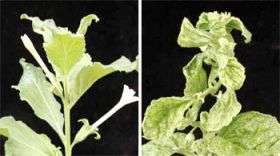Plant virus spreads by making life easy for crop pests

(PhysOrg.com) -- In 752, Japanese Empress Koken wrote a short poem about the summertime yellowing of a field in what is thought to be the first account of a viral plant disease. More than 1,250 years later, scientists concluded that the virus Koken described was part of the particularly insidious geminivirus family that continues to decimate tomato, tobacco and cotton crops worldwide. Now, new research shows how cunning an enemy one of these ancient viruses can be, manufacturing a protein that deforms and sterilizes plants and at the same time wrecks their defenses against the pests that spread the disease to others.
Researchers at The Rockefeller University have found that βC1, a toxic protein produced by the tomato yellow leaf curl China virus (TYLCCV), mimics the behavior of one of two different molecules that govern the development of leaf shape and vein structure. In doing so, it throws the plants off course, causing the unseemly curling and crumpling of leaves and the production of sterile flowers. But it also suppresses the plants’ jasmonic acid response, a defense mechanism against pests feeding on the plants. The result is that the pests — in this case whiteflies that plague tobacco plants — flourish in the diseased crop, spreading the virus faster and faster. Nam-Hai Chua, Andrew W. Mellon Professor and head of the Laboratory of Plant Molecular Biology, and his colleagues published the work in Genes and Development.
“This is a new way to look at the relationship between viruses, plants and vectors,” says Jun-Yi Yang, a postdoc in Chua’s lab who did the research. “If you just look at viruses and host plants, you can’t explain why the whiteflies tend to congregate on infected plants. Our research explains how the disease can spread so fast.”
The researchers inserted a gene that produces βC1 into Arabidopsis plants, model organisms for studying plant biology. The plants grew up with symptoms very similar to those of tobacco plants infected with TYLCCV. Yang and colleagues found that these mutants had the same problems as plants that overproduced a protein known as Asymmetric leaves 2 (AS2), which along with Asymmetric leaves 1 (AS1), regulates crucial elements of a plant’s development. In effect, βC1 poses as AS2 and interacts with AS1, upsetting the healthy development of plants. But it also weakens the response of genes that normally boost the jasmonic acid defense against the threat of an invasive pest, the researchers found.
The discovery of how a toxic protein manipulates the relationship of the plant and the whitefly to favor the virus could lead to a more comprehensive strategy for fighting the disease. “You need to fight against both viruses and insect vectors,” Yang says. “If you can increase the jasmonic acid response, you’ll have a better chance against whiteflies.”
Citation: Genes and Development 22: 2564–2577 (September 2008)
Provided by Rockefeller University

















